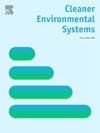Spherical sustainability in construction and demolition: How aligned are policies, goals, regulations, markets, and stakeholder mindsets?
IF 6.1
Q2 ENGINEERING, ENVIRONMENTAL
引用次数: 0
Abstract
Rapid urbanization in developing countries has intensified Construction and Demolition (C&D) socio-environmental impacts, substantially contributing to global environmental pollution and degradation. Despite numerous efforts, existing frameworks remain fragmented, often neglecting the full spectrum of indicators and stakeholder priorities, thus revealing critical gaps between sustainability policies, market dynamics, and stakeholder implementation. Considering the growing complexity and variety in construction methods, bridging the gap between theoretical models and real-world practices has become essential. This research addresses these challenges by covering 21 C&D-caused pollutants and identifying existing conflicts through a holistic framework encompassing the entire C&D lifecycle. It was achieved through an iterative process that integrates the Parsimonious Spherical Fuzzy Analytical Hierarchy Process (P-SF-AHP), Circular Life Cycle Sustainability Assessment (C-LCSA), and pre- and post-statistical analyses. A systematic mapping of construction activities with Sustainable Development Goals (SDGs), Green Building Rating Systems (GBRSs), and international standards established a network balancing scientific rigor with multi-stakeholder decision-making. The methodology employed an extended Delphi process, engaging 43 multidisciplinary experts over six months in 2 + 2 rounds, weighting 21 pollutants across nine categories. The findings underscore the primacy of air, noise, and water pollution in regional contexts while revealing conflicts within existing strategies and standards. The resulting framework provides stakeholders with quantitative tools for C&D-caused pollutant assessment, supporting the transition from linear to spherical sustainability models in rapidly urbanizing regions.
求助全文
约1分钟内获得全文
求助全文
来源期刊

Cleaner Environmental Systems
Environmental Science-Environmental Science (miscellaneous)
CiteScore
7.80
自引率
0.00%
发文量
32
审稿时长
52 days
 求助内容:
求助内容: 应助结果提醒方式:
应助结果提醒方式:


